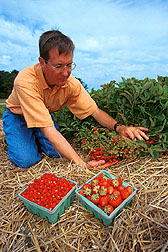 U.S. consumers wasted 150,000 tons of food daily from 2007-2014, with fruits and veggies topping the list.
U.S. consumers wasted 150,000 tons of food daily from 2007-2014, with fruits and veggies topping the list.Food Waste Resonates Beyond the Trash Bin
By Jan Suszkiw
April 18, 2018
GRAND FORKS, NORTH DAKOTA, April 18, 2018—Here’s a thought to chew on before you toss out that unfinished meal or oddly shaped fruit or vegetable: U.S. consumers waste nearly a pound of food per person per day. So says a study published today by a team of Agricultural Research Service (ARS) and university scientists in the journal PLOS ONE.
That food waste, in turn, is equivalent to about one-third the daily calories that each American consumes—about 327 million individuals. Interestingly, fruits and vegetables—key components of a high-quality diet (as defined by the 2015-2020 Dietary Guidelines for Americans)—were the most wasted food items, the team determined from their computer-aided analysis of eight years of available food survey data.
Zach Conrad, a postdoctoral nutritionist with the ARS Grand Forks (North Dakota) Human Nutrition Research Center, together with fellow nutritionist Lisa Jahns and colleagues from the University of Vermont and University of New Hampshire, conducted the food-waste study to fill gaps left by prior research that sought to establish links between diet quality and environmental impacts. In this study, the team notes that food waste should be factored into such efforts because of the substantial resources used to produce food, including cropland and amendments like pesticide and fertilizer, as well as irrigation water.
For example, using a powerful computing tool known as the U.S. Foodprint Model, the team determined that from 2007 to 2014, U.S. consumers discarded 150,000 tons of food daily—waste that corresponded to the yearly use of an estimated 30 million acres of land (7 percent of total U.S. harvested cropland), 780 million pounds of pesticide, 1.8 billion pounds of nitrogen fertilizer and 4.2 trillion gallons of irrigated water. Each represents potential costs to the environment and the farmers who dedicate their time, land and other resources to growing or raising food that’s meant to be eaten.
The study also found that—
- U.S. consumers wasted almost a pound (422 grams) of food per person daily, which is equal to 30 percent of daily calories consumed and 25 percent of daily food eaten by weight.
- Of 22 food groups studied, fruits, vegetables, and mixed fruit and vegetable dishes (39 percent of total) were wasted the most—followed by dairy (17 percent) and meat and mixed-meat dishes (14 percent).
- Growing fruits and vegetables—signatures of diet quality required less land than other crops but more water and pesticide.
The researchers note that while their study used the best-available food survey data, there are limitations to it and that additional research is needed. The findings nonetheless underscore the importance of improving diet quality hand in hand with using measures that reduce food waste and avoid overburdening the environment. Efforts like the U.S. Food Loss and Waste Challenge to create greater awareness of food waste issues, educating consumers on properly preparing and storing fruits and vegetables, and discerning natural ripening from spoilage can also help.
“Food waste is an issue that plays out at many different levels,” says Conrad. “Looking at them holistically will become increasingly important to finding sustainable ways of meeting the needs of a growing world population.”
The Agricultural Research Service is the U.S. Department of Agriculture's chief scientific in-house research agency. Daily, ARS focuses on solutions to agricultural problems affecting America. Each dollar invested in agricultural research results in $20 of economic impact.
